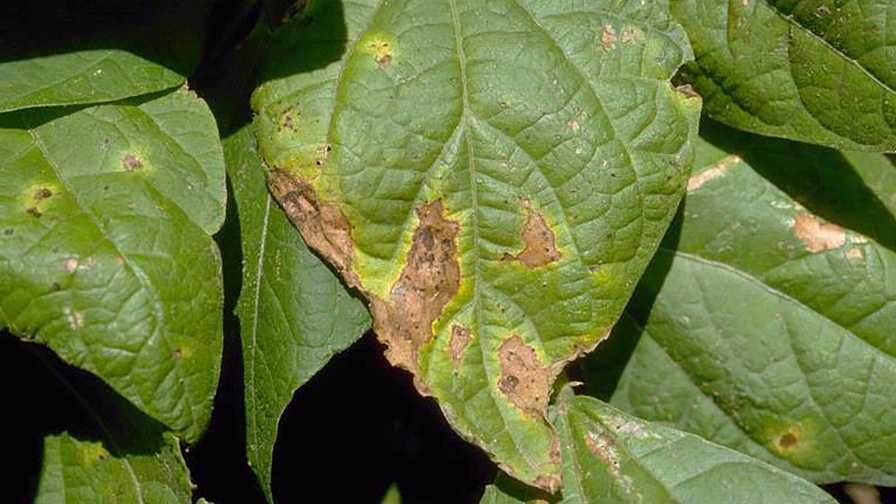Common Bacterial Blight of Beans Can Strike in a Snap

Common bacterial blight is the most frequently encountered bacterial disease of snap bean in Florida.
Photo by Howard F. Schwartz
Common bacterial blight, caused by Xanthomonas campestris pv. phaseoli, can be severe during periods of warm, humid weather with heavy rainfall.
Leaf symptoms of common bacterial blight first appear as small, water-soaked spots on the underside of the leaves. The lesions become larger and develop into dry, brown spots with distinct, rather narrow, yellow halos. Spots may coalesce causing a general yellowing of leaves.
Symptoms on pods can be striking with development of large, water-soaked areas that are more or less circular and slightly sunken. As symptoms progress, pod lesions can become distinctly brick-red in color and deeply pitted. Under highly humid conditions, they may exude yellowish bacterial ooze that dries to a yellowish, crusty mass. Significant pod symptoms can appear with little foliar damage.
Survival and Spread
The causal bacterium of common bacterial blight is related to bacteria that cause devastating bacterial diseases of tomato, pepper, lettuce, and many ornamental crops in Florida. X. c. pv. phaseoli has a limited host range, affecting snap bean, dry beans, and a few other members of the legume family.
Contaminated seed is probably the major source of bacteria introduced into new fields. Water-soaked lesions in young bean plants may be caused by cells of X. c. pv. phaseoli from seed as these cells invade emerging seedlings. The bacterial cells may colonize the surface of shoot tissues, inciting disease later, when favorable conditions are present.
The disease may survive in crop debris in the soil from season to season but is probably limited in South Florida because decomposition of crop debris is rapid and complete under hot, wet summers. Alternative weed hosts may also serve as sources of inoculum in Florida.
Rainfall or overhead irrigation is conducive to disease development and progression in the field. Splashing water spreads the bacterial pathogen from diseased plants to healthy plants.
Cells of X. c. pv. phaseoli enter bean plants through openings, such as stomates (breathing pores) in leaves and other plant organs and through hydathodes (vein endings) at margins of leaves.
Wounding of plants, such as that created by wind-blown soil particles, can create portals for ingress of blight bacteria. Bacteria are also readily transmitted mechanically, especially when field plants are wet. Insects such as whiteflies, leafminers, and beetles may transmit the bacterium from plant to plant.
Management Methods
Plant pathogen-free seed, preferably from plants grown in dry environments, under furrow or similar irrigation.
Avoid movement through and work in fields when plants are wet. This simple, cultural practice can greatly reduce blight disease development and spread. Promptly destroy crops and disc
in residues.
Control leguminous weeds that may serve as inoculum reservoirs. Insects should be properly controlled, particularly whiteflies.
Frequent scouting is important, as sprays of fixed copper bactericides/fungicides may provide benefit if applied at first signs of the disease. Consult UF/IFAS recommendations for currently labeled products for control of common bacterial blight in Florida.










